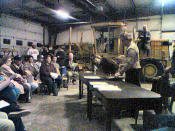 Dan
Meyer, a resident of Logan County, spoke briefly at the beginning of
the meeting to introduce the subject and state what he felt were the
concerns of the residents of the area. He said, "We're not against
the ethanol plant, just against where they want to put it." He said
that their objections began with concerns about the probability that
their property values would decline when the ethanol plant located
adjacent to their property. Dan
Meyer, a resident of Logan County, spoke briefly at the beginning of
the meeting to introduce the subject and state what he felt were the
concerns of the residents of the area. He said, "We're not against
the ethanol plant, just against where they want to put it." He said
that their objections began with concerns about the probability that
their property values would decline when the ethanol plant located
adjacent to their property.
In speaking with their friends and
neighbors, the list of concerns grew to include safety, environment,
noise, water consumption and the cost that county residents would
bear as a result of the ethanol plant's construction and operation.
A committee of eight people formed
to present the subject in a public forum: Dan and Marilyn Meyer, Ron
and Sharon Pierce, Gary and Ruth Freeman, and Brad and Angie Sheley.
Meyer spoke for the committee,
stating again that they were not against the ethanol plant, but that
they had major reservations about what they and others would have to
sacrifice for the 39 jobs that the ethanol plant would host.

Their main concerns were about the
influences the proposed plant would exert on their homes and
families. Meyer stated that according to the prospectus provided by
Illini Bio-Energy, only 60 of the 240 acres of purchased land would
be used for the construction and operation of the ethanol plant.
What would the remaining acreage be used for? Would other industrial
plants be able to locate on the remaining property without the right
local citizens usually have to state objections during the rezoning
process? Would there be safety concerns with trucks using Nicholson
Road to access the plant? Would the plant spew out pollution and
contaminants that would spoil the area?
Meyer stated that the group had done
some research but had not found any information on ethanol plants
that used coal to power the furnace to produce the ethanol, giving
way to further concerns about the safety of this means of
production.
Ethanol plants use a great deal of
water to produce their end product, and Meyer expressed a concern
that the plant would drain down the aquifer of water, rendering the
wells of local residents dry.
Meyer stated that the citizens of
Logan County would bear the cost of providing the infrastructure for
the plant, since the Lincoln and Logan County Development
Partnership agreed to present and recommend to the Logan County
Board the abatement of property taxes to the level of farmland rates
for the ethanol plant and the attached acreage. In addition, Meyer
stated, the development partnership would also present and recommend
the abatement of the county's portion of sales taxes on material
purchased in Logan County for the construction of the plant and for
the production of ethanol. Both of these abatements would be for a
period of 10 years.
Meyer closed his portion of the
program by stating that the thing that concerned the committee most
was the closed nature of this deal to put the ethanol plant on
Nicholson Road. "There has been no opportunity for citizens to
object in the process," he said. "Ground may already be purchased.
Things are being done quietly. We only get snippets." He concluded
by calling concerned citizens to make their opinions known in county
board meetings, in zoning commission meetings and in other public
meetings that have bearing on the location of this plant. "We need
to make our opinions known or we will have an ethanol plant in our
backyard," he said. "We need to have a united front and be
civilized about it."

Brian Wrage of Atlanta, a
representative and member of the board of directors of Illini
Bio-Energy, was on hand to make statements about the facility and
its proposed impact on the area and to answer questions.
Wrage opened by stating that the
property had not yet been purchased but was currently under contract
from the Perry Land Trust. The proposed site of the ethanol plant is
approximately where Camp-A-While is currently located. "Illini
Bio-Energy was not interested in the whole 240-acre parcel, but it
was the only way we could make the deal." The property needs to be
rezoned industrial.
[to top of second column in this article] |
 "Why there?" Wrage asked. The key is
rail access. Most of the product will be taken out by rail. And
access to the CN railroad line would allow Illini Bio-Energy to save
approximately $1 million a year on shipping. Burning coal instead of
natural gas would enable them to save an additional $3 million a
year. These two things would help the plant to be profitable sooner.
The market for ethanol is growing
since the fuel additive MTBE is being outlawed on the East Coast.
When MTBE is spilled, it has a great environmental impact, ruining
wells and drinking water sources. "When you spill ethanol in a
creek, you get drunk fish," Wrage said, comparing the ethanol
product to the alcohol contained in beer. Ethanol produces a safe,
clear flame when burned.
Wrage attempted to calm the crowd's
environmental fears, stating that the ethanol product cannot escape
from the plant. He said that everything would be done according to
EPA specifications. The coal would be prewashed, and there would be
adequate technology to deal with the grain dust. Lime would be used
in the furnace, along with scrubber technology to take the sulfur
out of the stack effluent from burning the coal. He added that the
ethanol plant would have its own fire protection system and
personnel.
The plant will not produce a
discernible odor like the Decatur ADM or Staley plant. "We will not
have that fermenting grain smell from the dryers," he said. All the
odors from the process will be fed back into the furnace and be
re-burned.
The ethanol plant has been designed
to use 80 percent Western coal, 20 percent Illinois coal at startup.
Illini Bio-Energy recently ran a test and determined that they can
theoretically use all Illinois coal if there was the financial
incentive to do that.
Ethanol is the biggest thing to hit
agriculture in about 40 years. It enables farmers to have an
alternative market for their corn. And the impact to the county
would come from investors and consumers across the country. Money
would be coming in from all over to enrich the county.

Wrage talked further about the
physical changes that would have to be made to the area. He said
that the hill on Nicholson Road would have to be shaved down. In
addition to that, the board of Illini Bio-Energy has been talking to
AmerenCILCO about increasing the size of the power substation on the
corner of Nicholson and Route 66 to occupy about two acres of the
ground in order to better serve their customers to the north.
Concerning the subject of water
consumption, Wrage stated that the plant would consume some 350 to
700 gallons of water per minute. That water would never be
discharged except as steam. The water would be produced from drilled
wells or brought in by pipelines from other areas or purchased from
Illinois American Water.
There are currently 35 dry-mill
ethanol plants of this same design either in operation or in
construction, including ones in similar residential areas such as
Robinson in Illinois and West Burlington in Iowa. Among those
plants, there are three currently under construction that will use
coal to produce ethanol.
Wrage finished with an estimate that
the plant would contribute some $300,000-$600,000 per year to the
property tax coffers. At this point the meeting began to degenerate
when a member of the audience said that amount would not even pay
for the upkeep of the roads necessary to service the plant. Many
other comments were offered by the audience, and toward the end,
comments were quickly traded back and forth between Wrage and the
audience in a heated fashion.
[Jim
Youngquist]
 |

